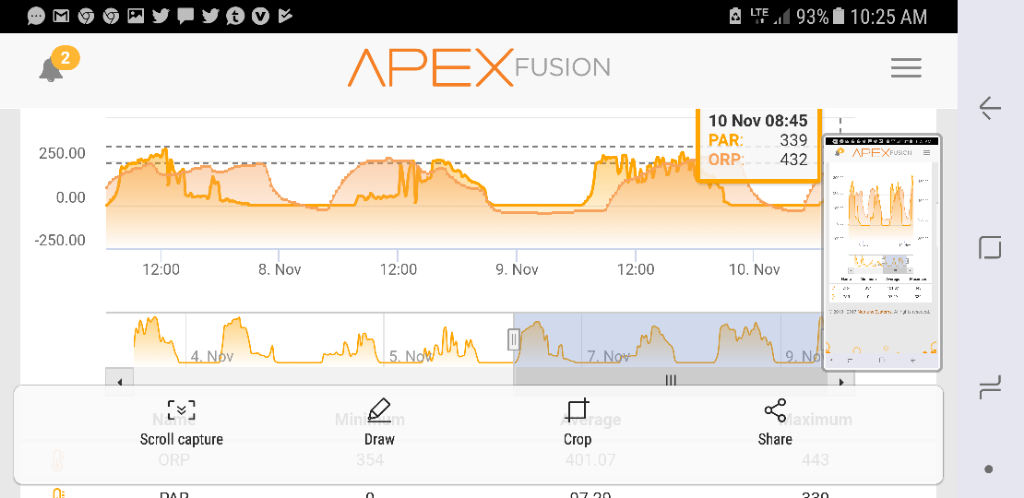It is no secret that a higher ORP corresponds with increasing clarity and as such, higher measured PAR.
In doing some tweeking I found something interesting. Even when the water is visibly "crystal clear" you can still measure differences in PAR with even higher ORP numbers.
As I use both Instant Ocean and Fritz I have found that with my AWC system my ORP stays a bit depressed when on IO and will raise drastically when running Fritz.
The highest ORP numbers I get on IO will be around 375 with averages in the low 300s. When running Fritz I see numbers well into the 450s and 460s and occasionally hit my safety shut value, shutting down the ozone generator (I already don't run it at night as it is so it is very unusual for me to hit a peak value as it spends have the day raising back up from what ever low value it hit will being off).
What I observed just now is that I had my lights dialed in to a value I had chosen as the highest par numbers I was comfortable with (just over 300) in the hottest spots...and then after switching to fritz I was getting numbers as high as 360 at times. This means that you can potentially get a PAR swing with a high confidence rate by as much as 10%...and to a lesser confidence rate I will say that the swing could be as much as 20%, based not only on the old adage of (you get a spike when you change your carbon or do a big water change and get cleaner water) but also....based on the salt brand you pick.
I never would have believed it as the tank appears crystal clear to my eye using either and I couldn't imagine it making much difference in PAR even worth mentioning but I feel fairly confident that I could graph this out in a trend line fairly convincingly.
Unfortunately I have been tinkering and moving my PAR meter around in the tank and also trying to adjust my lights down so as not to over light my corals so my current graph lines suck and wouldn't show what I am explain but as I said, after my observations I feel it could be graphed fairly easily.
This may only be true in a tank where ozone is actively running. I have NO IDEA what the various impacts on ORP from different salt brands would be in a tank not running ozone...and in fact, many/most people don't even monitor ORP so are unaware of the ORP differences associated with different salt mixes.
This may also not be measured the same on someone NOT running continuous AWC water changes because it has been documented that the shifts in ORP from water changes are not sustained long term/are temporary shifts for people who do batch water changes.
In doing some tweeking I found something interesting. Even when the water is visibly "crystal clear" you can still measure differences in PAR with even higher ORP numbers.
As I use both Instant Ocean and Fritz I have found that with my AWC system my ORP stays a bit depressed when on IO and will raise drastically when running Fritz.
The highest ORP numbers I get on IO will be around 375 with averages in the low 300s. When running Fritz I see numbers well into the 450s and 460s and occasionally hit my safety shut value, shutting down the ozone generator (I already don't run it at night as it is so it is very unusual for me to hit a peak value as it spends have the day raising back up from what ever low value it hit will being off).
What I observed just now is that I had my lights dialed in to a value I had chosen as the highest par numbers I was comfortable with (just over 300) in the hottest spots...and then after switching to fritz I was getting numbers as high as 360 at times. This means that you can potentially get a PAR swing with a high confidence rate by as much as 10%...and to a lesser confidence rate I will say that the swing could be as much as 20%, based not only on the old adage of (you get a spike when you change your carbon or do a big water change and get cleaner water) but also....based on the salt brand you pick.
I never would have believed it as the tank appears crystal clear to my eye using either and I couldn't imagine it making much difference in PAR even worth mentioning but I feel fairly confident that I could graph this out in a trend line fairly convincingly.
Unfortunately I have been tinkering and moving my PAR meter around in the tank and also trying to adjust my lights down so as not to over light my corals so my current graph lines suck and wouldn't show what I am explain but as I said, after my observations I feel it could be graphed fairly easily.
This may only be true in a tank where ozone is actively running. I have NO IDEA what the various impacts on ORP from different salt brands would be in a tank not running ozone...and in fact, many/most people don't even monitor ORP so are unaware of the ORP differences associated with different salt mixes.
This may also not be measured the same on someone NOT running continuous AWC water changes because it has been documented that the shifts in ORP from water changes are not sustained long term/are temporary shifts for people who do batch water changes.
















